One of the most burning questions any advertiser asks themselves is: “How much do Facebook Ads cost?”
As you’ll soon see, the only true answer is “It depends.”
The truth of the matter is that how much you pay for your Facebook ads will vary depending on the month, day, hour, and location (and those are just a fraction of the variables at play).
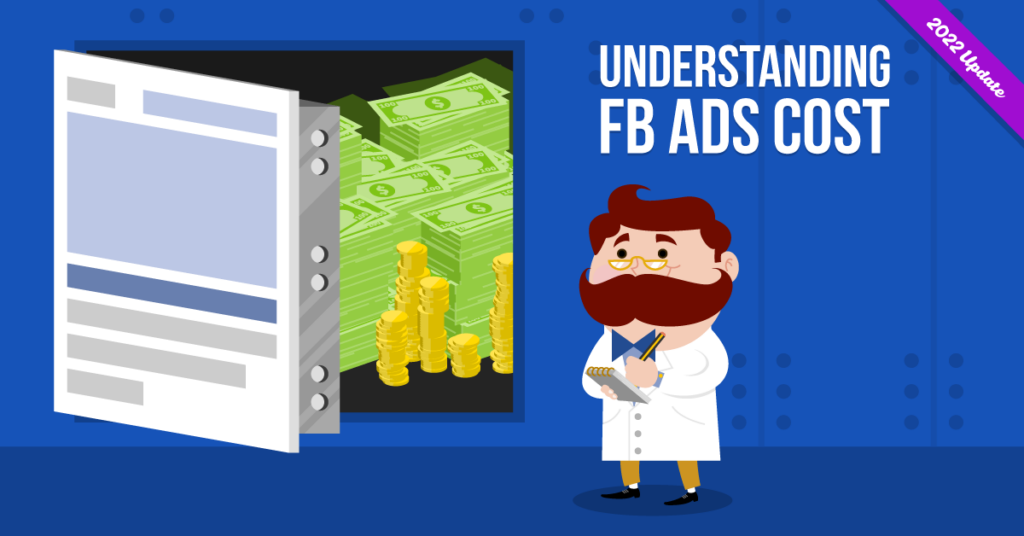
As an advertising platform, AdEspresso has managed over $636 million in ad spend. In this article, we’ll use this information to provide you Facebook Ad cost averages for 2021 and 2020 so you can budget for 2022.
We’ll also include the previous year’s information to give you more historical context for your benchmarking.
So buckle up because you won’t find Facebook Ads Cost benchmarks that are as comprehensive, precise, or based on as large a data set anywhere else.
Before you read any further, keep in mind that this article will not tell you exactly how much your specific campaign is going to cost, but it will give you some benchmarks to set your own KPIs.
If you are interested to know how much you need to spend to achieve your own targets, you can use our handy Ads Cost Calculator to do so.
In this 2021/2022 edition of our Facebook Ads cost guide, we’ll cover:
We’ll cover differences based on the month, day of the week, and hour of the day. We’ll also explain the top factors involved in the cost of advertising with Facebook and the steps you can take to reduce them.
Want a shareable guide for your colleagues or clients? Download our free e-book. It contains all the 2021 benchmarks for Facebook Ad costs you see here, plus tips for how to understand the data.
How Does the Bidding Process Work for Facebook Ads?
Before we go into costs, it’s important that we take a second to talk about the bidding process.
Because advertising on Facebook is more like an auction house than a guaranteed bet, there will always be a change in your cost that you cannot control. However, you can set the odds in your favor by using smart bidding strategies.
When you create a campaign, you can adjust your bid on the pricing and bidding section. If you don’t, Facebook will automatically calculate a bid for you based on your budget and how long you choose to have your ad run.
As we mentioned before, it’s important to remember that this is an auction and you are bidding against every other advertiser on the platform. This means that at any given time you have hundreds upon hundreds of other advertisers all going for the eyes of Facebook users.
Ensuring you have a good bidding strategy in place will allow you to remain competitive, and give your ads a better shot at delivery.
There are a large number of factors that can affect how much your Facebook Ads cost, and bids are only one of them.
These factors can include:
-
The timing.
The month of the year, the day of the week, and even the specific hour of the day can affect ad costs. There are peak times and when the competition is highest, the costs go up.
-
Your bidding strategy.
Whether you select the lowest cost or choose a specific bid cap can ultimately determine your ad delivery and cost.
-
The placement you choose.
Different ad placements will have different costs – the more competition a certain placement has, the higher the cost.
-
Relevance metrics.
Facebook has 3 separate metrics to determine the quality of your ad: Engagement Ranking, Quality Ranking, and Conversion Ranking. Having a low score in any of these areas will increase your costs.
-
The audience you’re targeting.
If other advertisers are trying to reach the same audience members, costs go up as newsfeed space is not unlimited.
At the end of this post, we’ll link some resources to help you decrease your Facebook ads costs by addressing some of the issues we mentioned above.
Facebook Ads Cost: 2021 and 2022 Benchmarks
Now that we’ve got a clear idea of how the bidding system works and what factors currently are most heavily affecting the cost of our Facebook Ads, let’s take a look at the data.
This data was pulled from all AdEspresso users from 2020 and 2021 and encompasses over 636 million in ad spend. We converted all currencies to USD.
While all the statistics in this post are coming from real campaigns, you should be using these numbers only as a reference or a guideline.
Now, onto the good stuff!
Cost Per Click Results
This data reflects the average Facebook Cost per Click for 2020 and 2021.
This information is limited to campaigns with website clicks or website conversions as the objective unless otherwise noted. The currency is in USD.
Cost Per Click by Month – 2020
If you look at the 2020 CPC graph, the cost-per-click peaked in February 2020. This goes against the grain of a typical year, where costs are lower in the first few months of the year and then rise during the rest.
This was due to the decreased ad spend due to COVID-19, as well as the limited supply chain for eCommerce advertisers.
The beginning of the COVID-19 pandemic caused panic among business owners, and lots of them, unsure of the future, significantly decreased their ad budget. For this reason, the ad cost was lower than usual between March and December 2020.
Even in Q4, there wasn’t a rise in CPC, perhaps because businesses were still being cautious with budgets, preferring to conserve cash and bide their time rather than take advantage of lower traffic costs.
So how exactly did the early months of 2020 compare to the year before?
The most significant drop in CPC occurred in April when the average came down to $0.33. This is $0.10 (or 23%) lower than in April 2019.
Cost Per Click by Month – 2021
Compared to the same period in 2020, the first months of 2021 saw low average CPCs. At the beginning of the year, much of the world was in lockdown or living with COVID-related restrictions.
This meant people were spending a lot of extra time online and using social media. This, in turn, led to surplus ad capacity. CPC is usually determined by the amount of competition from other advertisers; low demand for ad space in Q1 drove ad prices down.
As the world opened up again in Q2 and beyond, users spent a lot less time online, and less ad capacity pushed the price per ad impression upwards.
Each year we see a trend of cheaper clicks in Q1 and then the year finishing with very expensive clicks during the Q4 holiday season, so the 2021 results are no surprise. The CPC is usually determined by the amount of competition from other advertisers; when demand for ad space is low in Q1 it’s possible to pay less per ad impression.
At the other extreme, there’s a huge amount of ads booked by eCommerce brands in Q4 which pushes up the ad costs significantly. Pay attention to your business during these months. If you primarily rely on B2B leads, competing with eCommerce advertisers during Q4 might not bring the ROI you need.
Cost Per Click by Day of the Week – 2020
In both 2019 and 2020, the average CPC was slightly lower during the weekends.
Differences between weekday and weekend CPCs got smaller during the peak of COVID-19. In 2019, the fluctuation in cost-per-click between weekdays and weekend days was up to ten cents, and in 2020, it was only two-three cents.
The number of active advertisers remains almost the same throughout the week. Still, the number of active social media users increases on the weekend, increasing the ad space’s size and effectively making the CPC more affordable.
That said, the day of the week should not be a deciding factor when setting up your Facebook Ads campaign. Instead, focus your strategy on the unique nature of your business and niche, and the high-demand seasons in your industry.
Cost Per Click by Day of the Week – 2021
In 2021, CPC has been remarkably stable throughout the week.
B2B advertisers are often tempted to only run campaigns only on weekdays, and B2C advertisers tend to prefer weekdays, but data suggests that campaigns should run 7 days a week.
95% of Facebook ad impressions are served on mobile devices, which means that the effectiveness of ads is no longer tied to whether their audience is behind their office PC or relaxing at home with their laptop.
Ad audiences can now go online whenever and wherever they are, which means they’re surfing Facebook and clicking on ads 7 days a week.
Cost Per Click by Hour of the Day – 2020
During Q4 in 2020 we can see that there were very few hours with a lower CPC as the CPC stayed more or less the same right up to midnight and only then saw a small drop overnight.
Something worth remembering is that approximately 95% of Facebook Ads are delivered to mobile devices and users are checking Facebook at all times of the day (and night) including when they are in bed.
Cost Per Click by Hour of the Day – 2021
On average, CPC is the lowest between midnight and 6 am in any time zone. This is likely due to the fact that some advertisers turn their ads off overnight, and there is less competition than during the daytime.
The data suggests ads should be left running overnight, though, to take advantage of the cheaper pricing — or so you’d think.
The number of clicks will be much lower overnight, as fewer users will be online. So we don’t recommend running campaigns overnight only. Instead, run your campaigns 24/7 and let Facebook find the best opportunities throughout the day and across the week.
Cost Per Click by Campaign Objective – 2020
For most campaign objectives the CPC declined as the year progressed until Q4 when it increased again. Q4 can be a very competitive time of year due to increased ad spend from ecommerce brands pushing up the auction price for ad space.
Therefore when planning your ad budgets, think about your budget across the whole year instead of just spending an equal amount every month.
If your brand doesn’t sell goods and services related to the holiday season, consider spending more of your ad budget during Q1-Q3. Then in Q4, reduce budgets and focus just on remarketing campaigns that use smaller audiences.
Cost Per Click by Campaign Objective – 2021
The graph below compares the average cost of clicks on Facebook ads with different objectives throughout 2021. The data illustrates how good the Facebook algorithm is at achieving the objective you set for it.
If your main goal is to generate clicks to your website, setting your objective as such leads to the cheapest CPC. For all other campaign types, the CPC increases as clicks become a secondary goal to the Facebook optimization algorithm.
Clicks on lead generation ads are much cheaper than clicks on conversion campaigns. If you are looking to generate leads, using an on-Facebook lead generation form could be more effective than using the conversion objective and capturing leads on your website.
The conversion objective can be a good choice even outside of lead generation campaigns, as it gets clicks at a reasonable cost and generates high-intent traffic. This, in turn, can translate to good conversion rates later on in the funnel, e.g., on your website.
But conversion campaigns are still a useful tool for performance marketers. They are better for generating website traffic than reach or impression ads, which should only be used for top-of-funnel awareness campaigns.
Cost Per Like Results
Running a campaign for page likes can be valuable in certain situations; it can get you followers quickly, however, it can also be a huge resource drain if done inefficiently.
This data shows the findings of all campaigns created with the Page Like objective in 2019 and Q1-3 of 2020.
Cost Per Like by Month – 2020
Advertisers running Page Like campaigns during March, April, and May 2020 saw unprecedented drops in CPL. Conversely, during October and November, the cost per like was very high. This was probably partly due to other advertisers building up their page audiences ahead of Black Friday and Cyber Monday.
In December the cost per like fell back down again, this could be because eCommerce advertisers were no longer building their warm audiences for remarketing.
In addition, brand awareness advertisers with yearly budgets typically exhaust their Page like budgets by December and this reduces competition during the auction process.
Cost Per Like by Month – 2021
In the early days of Facebook advertising, Page likes could be obtained for a few cents each, so, for many brands, it was financially feasible to focus on building up the number of Page followers.
But as the CPL has increased and organic post reach has declined over the years, using Page likes as a primary advertising objective stopped making as much sense.
With the cost per Page like rapidly rising during 2021, the move away from Page Like campaigns continues. With an average price of 38 cents per Page like, it would cost $380 to get 1,000 Page likes using paid ads.
If you do wish to run Page Like campaigns, consider keeping budgets low and focusing on remarketing to warm audiences. A prospect is much more likely to be willing to like your Page if they’ve already engaged with a selection of your other ads and boosted Page posts.
Cost Per Like by Day of the Week – 2020
In Q1 2020, the average CPL was the highest on Sunday, Monday, Thursday, Friday, and Saturday. Tuesday and Wednesday were the most affordable days to generate Page likes.
In Q2, however, Sunday, Monday, and Tuesday were the most affordable days of the week. In Q3, the average cost per like was the lowest on weekends and finally in Q4 Sundays and Mondays were the cheapest days.
As you can see, there really isn’t a predictable pattern you can follow to optimize for the lowest CPL. Instead of trying to strategize for the best days to get the cheapest Page likes, automate ad delivery and let Facebook do the math for you.
Cost Per Like by Day of the Week – 2021
The chart shows a trend for the cost per page like to be substantially cheaper at weekends, with the cost per like reaching an eye-watering $1 or more on certain weekdays in Q2 and Q3.
Usually, we recommend running campaigns 7 days a week as Facebook’s algorithm doesn’t like campaigns being paused and restarted all the time.
However, with such a variation in prices, we recommend running a breakdown analysis for your particular Page and seeing if there are any opportunities to save some advertising costs by being selective about when your Page Like campaigns run.
Cost Per Like by Hour of the Day – 2020
As opposed to CPC, CPL by hour was quite volatile quarter-to-quarter in 2020. Curiously, during the first quarters of both 2019 and 2020, the average cost-per-like was the highest during the night.
This data goes against our findings for the other years previous (2021 and 2018) where costs are traditionally cheaper during the night. Overall we consider this an outlier in the data set, and expect this number to return back to normal during 2022.
Cost Per Like by Hour of the Day – 2021
Page likes appear to be cheaper to obtain overnight, between midnight and 6 am in every time zone. However, not many Facebook users are online at that time of day, so we wouldn’t recommend scheduling your Page Like campaigns by the time of day.
Instead, follow our advice above and run a breakdown analysis for your particular Page and see if there are any opportunities to save some advertising costs.
Summary of 2021 Data (Overall)
If you’re looking for an abbreviated version of everything we just said, here’s a quick summary of our findings:
Summary of 2021 Facebook Ad cost benchmarks
Here’s a quick summary of 2021 Facebook ad costs:
- Average Cost Per Click by Month 2021
- January 2021 – $0.30
- February 2021 – $0.33
- March 2021 – $0.42
- April 2021 – $0.46
- May 2021 – $0.44
- June 2021 – $0.47
- July 2021 – $0.46
- August 2021 – $0.47
- September 2021 – $0.5
- Average Cost Per Like by Month 2021
- January 2021 – $0.20
- February 2021 – $0.23
- March 2021 – $0.32
- April 2021 – $0.29
- May 2021 – $0.52
- June 2021 – $0.49
- July 2021 – $0.45
- August 2021 – $0.48
- September 2021 – $0.39
- The average cost-per-click has been remarkably stable by day of the week throughout 2021.
- The average cost-per-click is the lowest between midnight and 6 am — but low reach during these hours makes the savings null.
- Lead Generation campaigns get much cheaper clicks than Conversion campaigns and could be more effective than using traditional landing pages.
- Conversion campaigns also result in good click-through rates (CTR) and high-quality traffic, and are a great choice for performance advertisers.
- Page Like campaigns are becoming increasingly more expensive and simultaneously less worthwhile to run due to declining organic reach on Facebook.
Want to take a look at our past findings on Facebook Ads cost? Keep on reading to check out our 2019 study.
But first, download the whole Facebook Ads Cost 2022 eBook. It’s completely free!
Facebook Ads Cost: AdEspresso 2019 Benchmarks
Cost Per Click Results
This data reflects the average cost per click (CPC) for 2019.
This information is limited to campaigns with website clicks or website conversions as the objective unless otherwise noted. The currency is in US dollars.
Cost Per Click by Campaign Objective – 2019
Even for the CPC by campaign objective metric, the cost seems to decrease month by month, just like other CPC-related metrics. If you compare the campaign objective CPC of 2019 with that of 2020, you’ll find that it is lower across the board for the latter year.
Your campaign objective should be determined by the stage of the funnel your potential customer is in. Using the wrong objective might result in unnecessarily high ad costs. From our years of experience, we can say with certainty that when it comes to driving traffic, impressions and reach objectives come with the highest cost.
Cost Per Click by Month – 2019
The average CPC rose from $0.31 in 2018 to $0.45 in 2019. The reason behind this increase lies in the supply and demand of ad space. The thing is: Facebook has more demand for ad space than it can supply. And what happens when demand exceeds supply?
You guessed right—costs increase, and that’s exactly what happened to Facebook CPC.
Cost Per Click by Day of the Week – 2019
In 2019, the fluctuation in cost-per-click between weekdays and weekend days was up to ten cents at it’s peak.
Additionally, the CPC tends to be slightly cheaper during the weekend.
Cost Per Click by Hour of the Day – 2019
In 2019, the costly hours started a couple of hours late, meaning that the hours between 10 AM to 10 PM were the most expensive ones.
Again, your approach to CPC-by-hour should depend upon the nature of your business. For example, ice creams and cold drinks are more likely to sell when it’s hot outside. People are more likely to order fast food on Friday nights.
Cost Per Like Results
Running a campaign for page likes can be valuable in certain situations; it can you to get more followers quickly, however it can also be a huge resource drain if done inefficiently.
This data shows the findings of all campaigns created with the Page Like objective in 2019.
Cost Per Like by Month – 2019
However, the cost-per-like increased from $0.16 in 2018 to $0.22 in 2019—which is quite a noticeable difference.
Cost Per Like by Day of the Week – 2019
Looking at the cost-per-like in 2019, the only predictble pattern was the increase in cost over time.
Cost Per Like by Hour of the Day – 2019
Luckily, CPL by Hour is a bit more predictable as compared to CPL by day of the week.
Just like with 2020’s data, the cheapest time to advertise for page likes is during the early hours of the morning. The caveat of this approach as always is that there are fewer people to reach during these times.
Summary of 2019 Data (Overall)
If you’re looking for an abbreviated version of everything we just said, here’s a quick summary of our findings:
- The CPC for conversion campaigns has decreased four consecutive quarters. Optimizing for conversions with Conversion objective campaigns is recommended
- Overall, the day of the week has little effect on the cost per click.
- While the nighttime price for CPC is lower, the traffic is much smaller. This means using dayparting is not as effective as it once was.
- The cost per page like has been on an increasing monthly trend from 2018 into 2019.
- As with the CPC, the cost per page like has little change by day of the week.
Final Thoughts
If you’ve made it to the end of this post, congratulations – you’re now a Facebook cost analyst. 🙂
As we mentioned before, there are plenty of factors that can affect how much you’ll be paying for Facebook ads, including your audience, relevance scores, and bidding strategies.
If you want to decrease your overall Facebook ad costs, we recommend optimizing your target audience, improving your ad relevance metrics, and studying up on the latest bidding strategies for starters!
Madis Birk is an independent Facebook Ads Consultant. A lean, mean, growth-focused Facebook advertising plug-in to your existing A-team. A digital marketing expert integrable into your winning strategy. If you want to get in touch with Madis, you can find him by going to www.madisbirk.com.
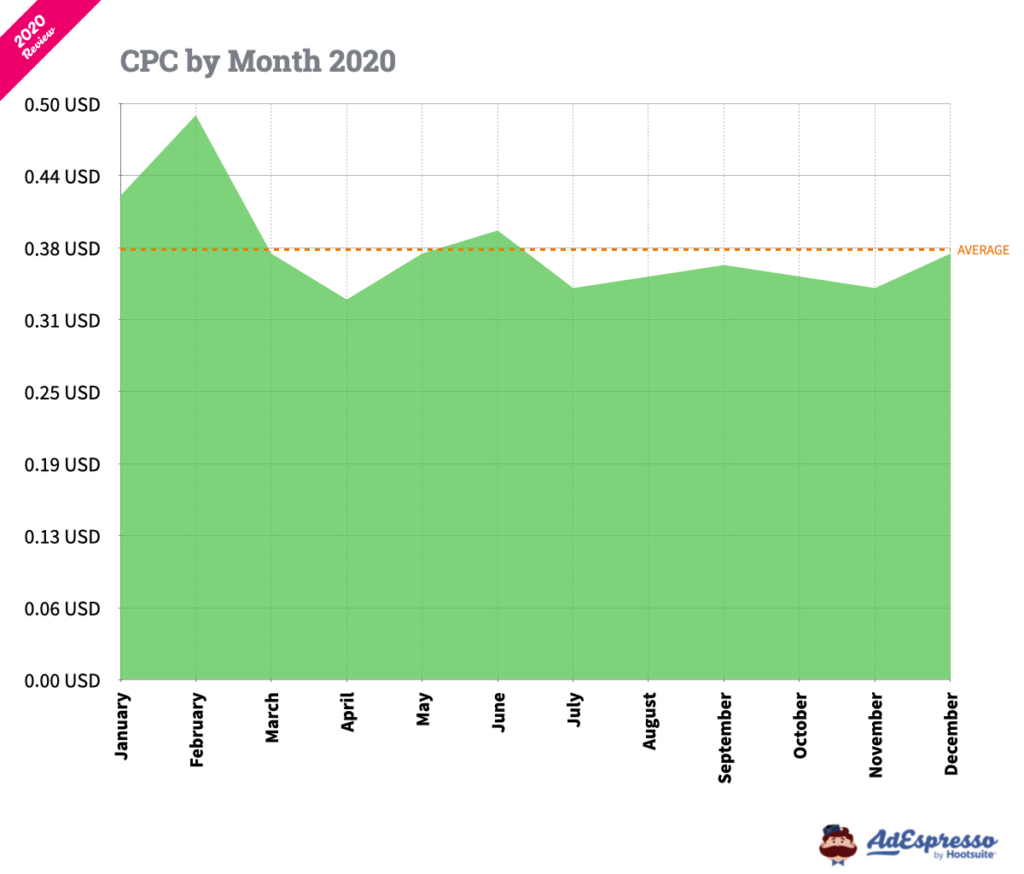

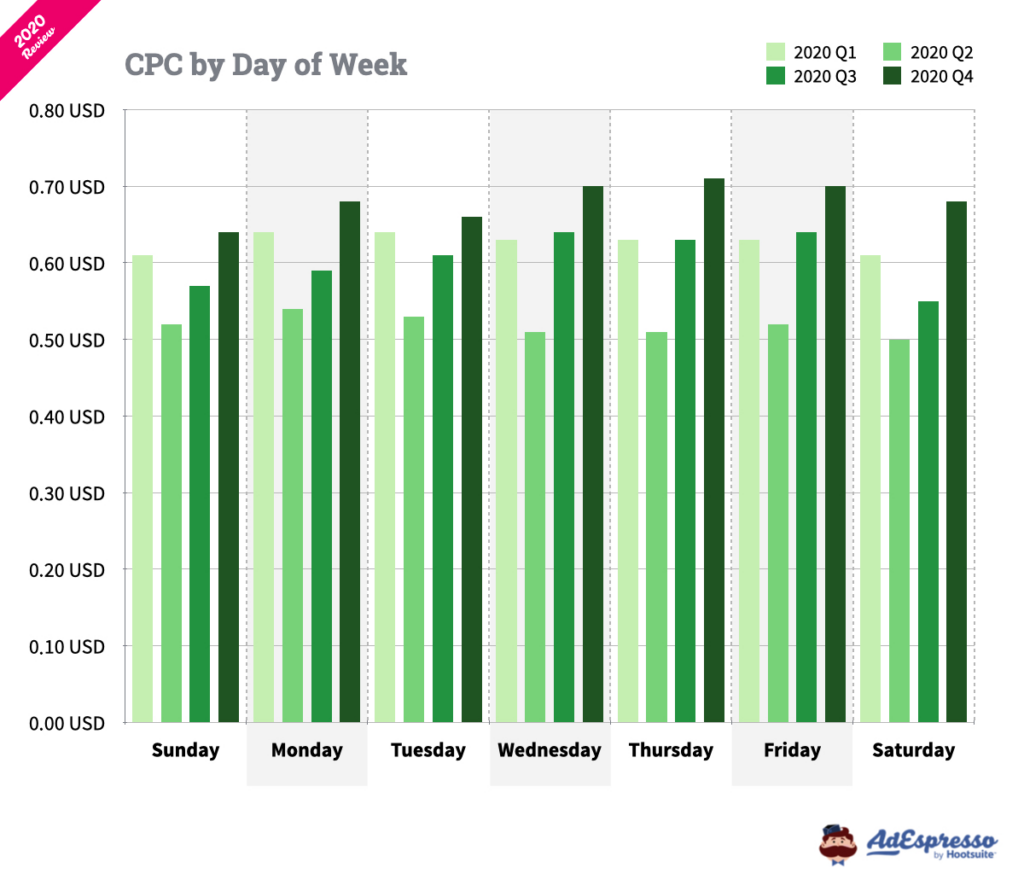
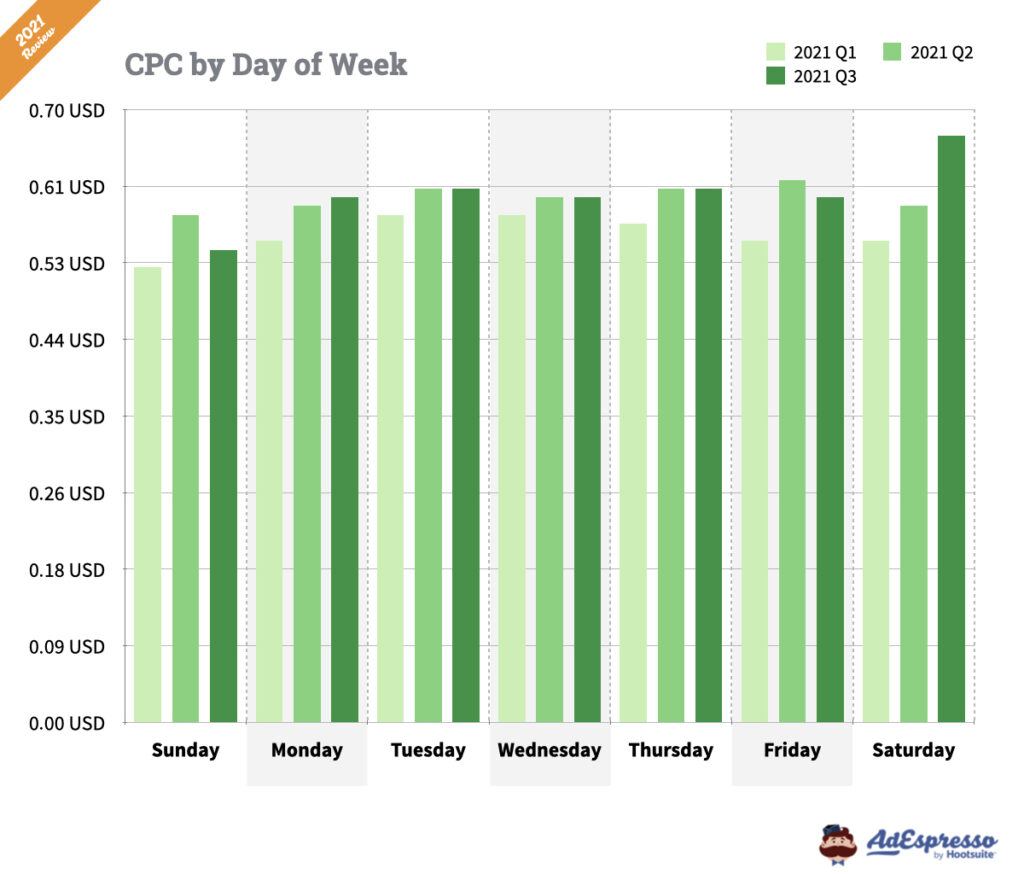
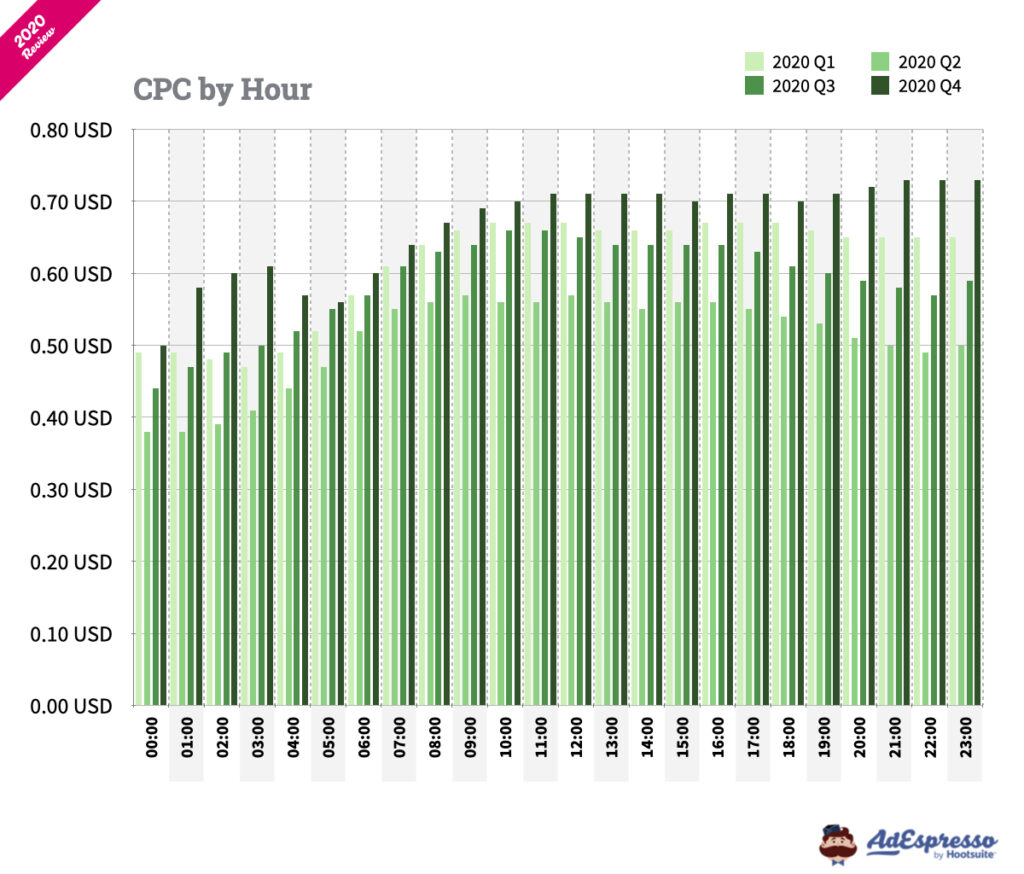
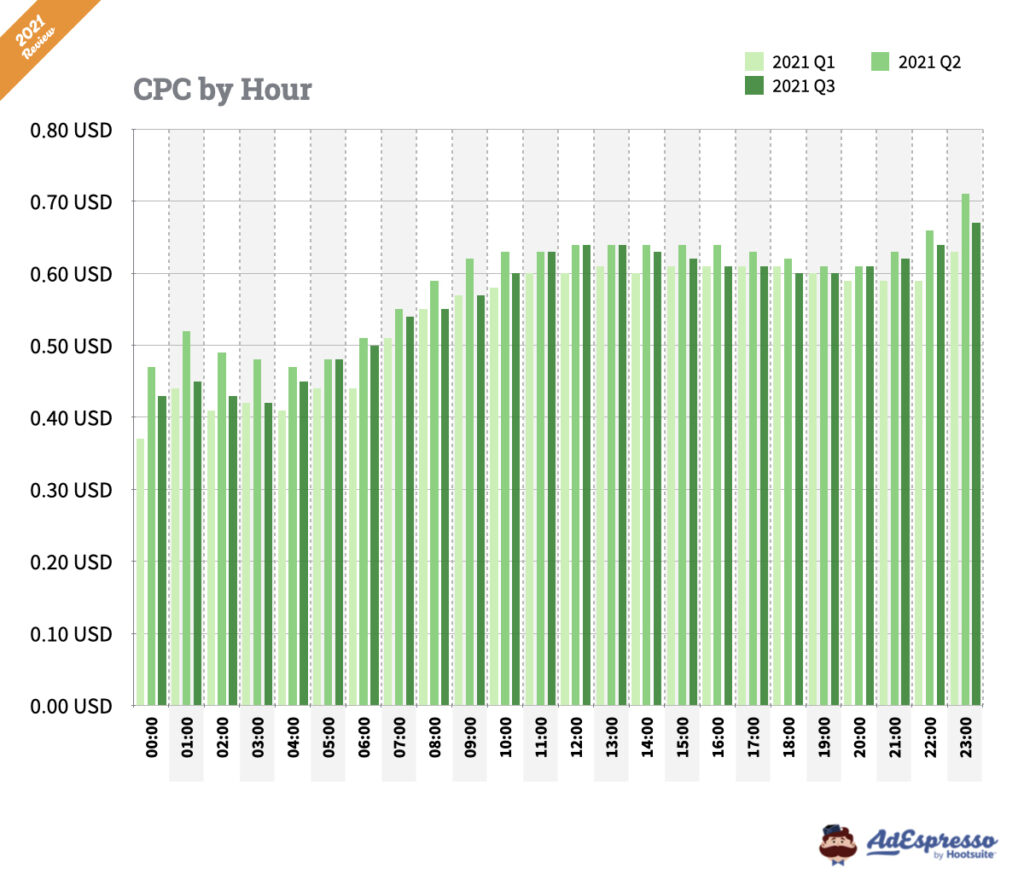
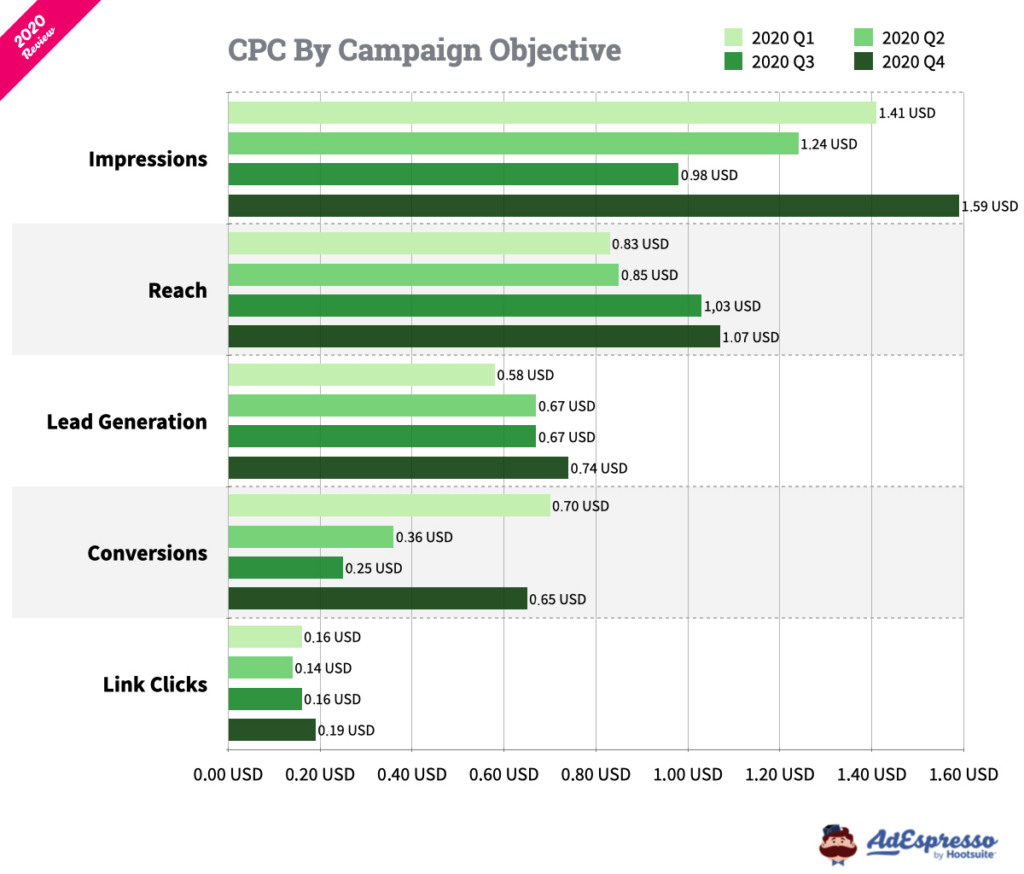
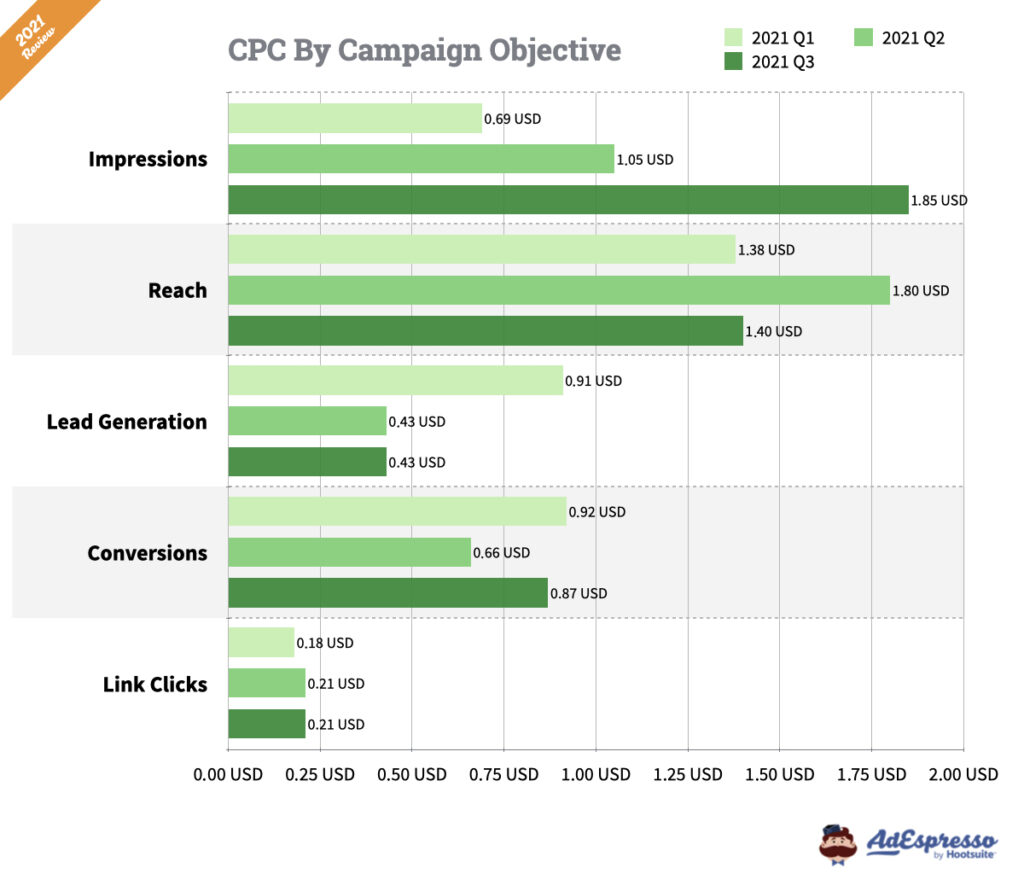
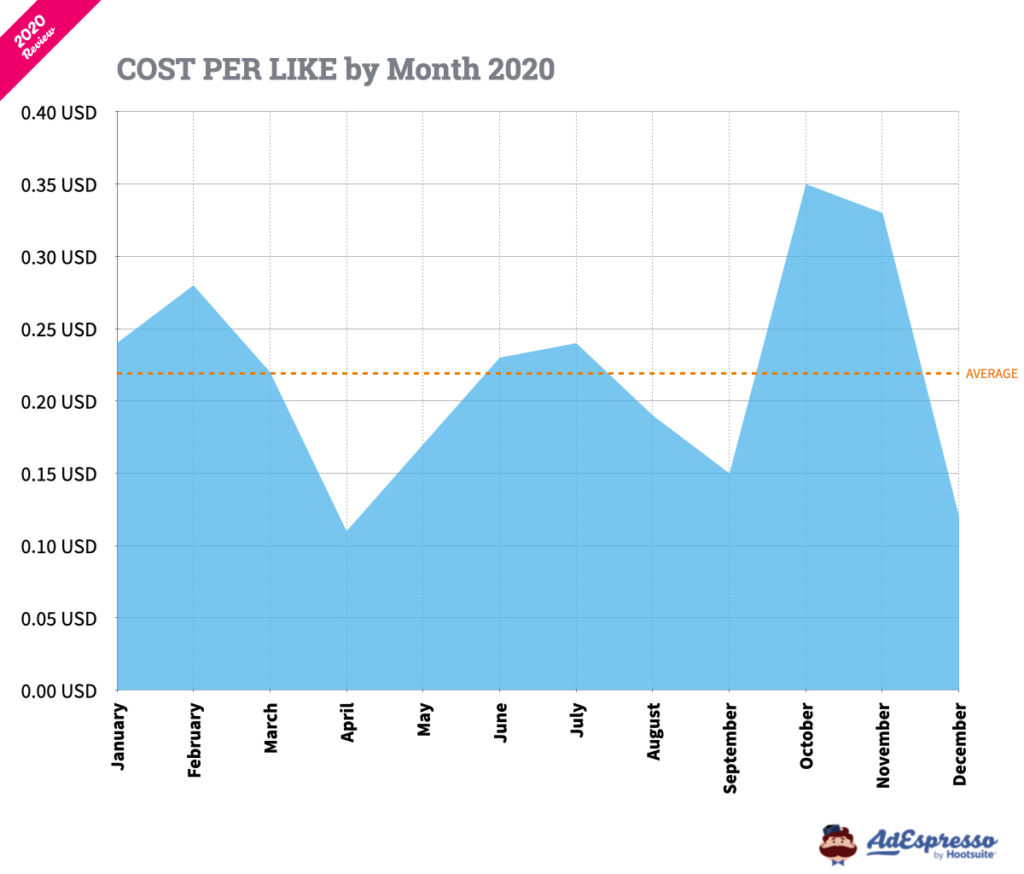
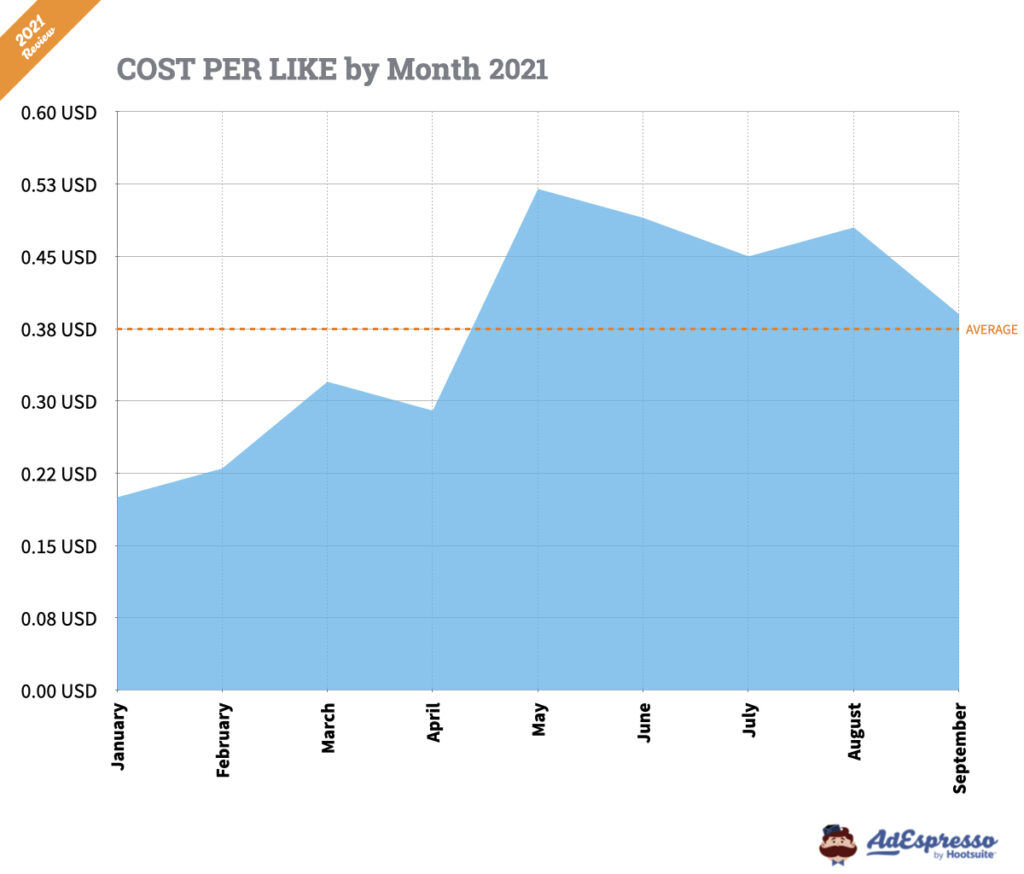

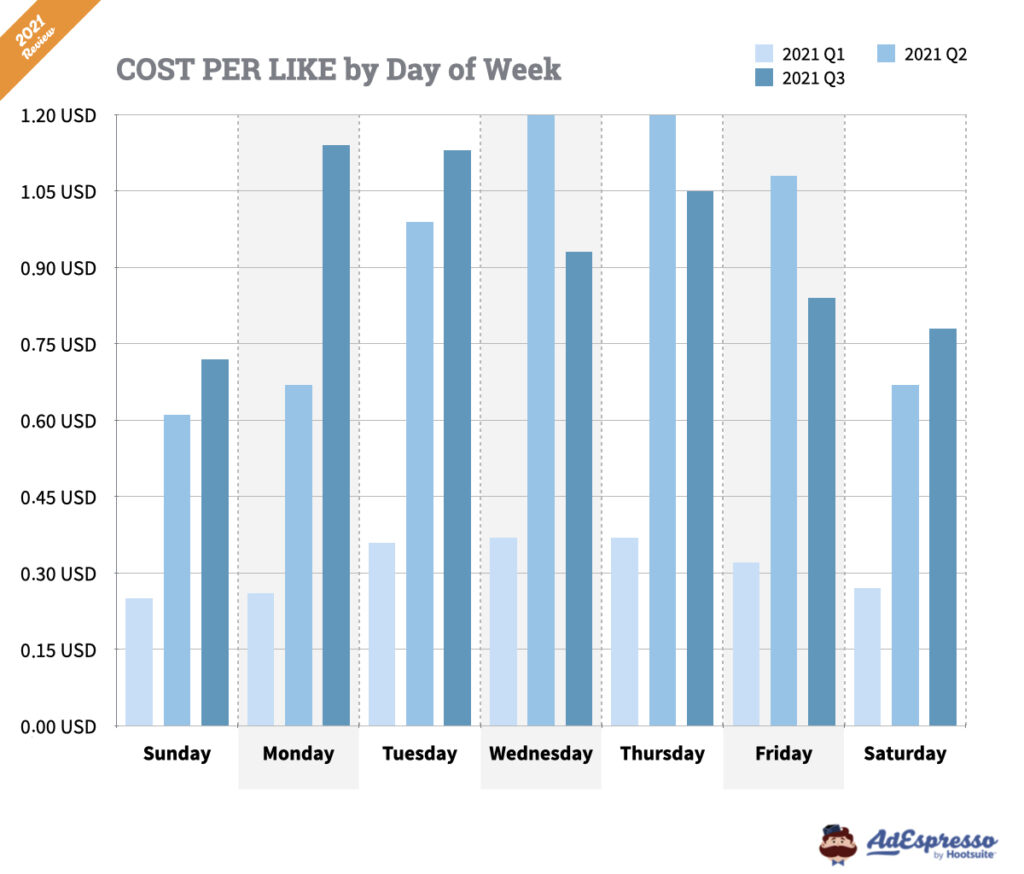
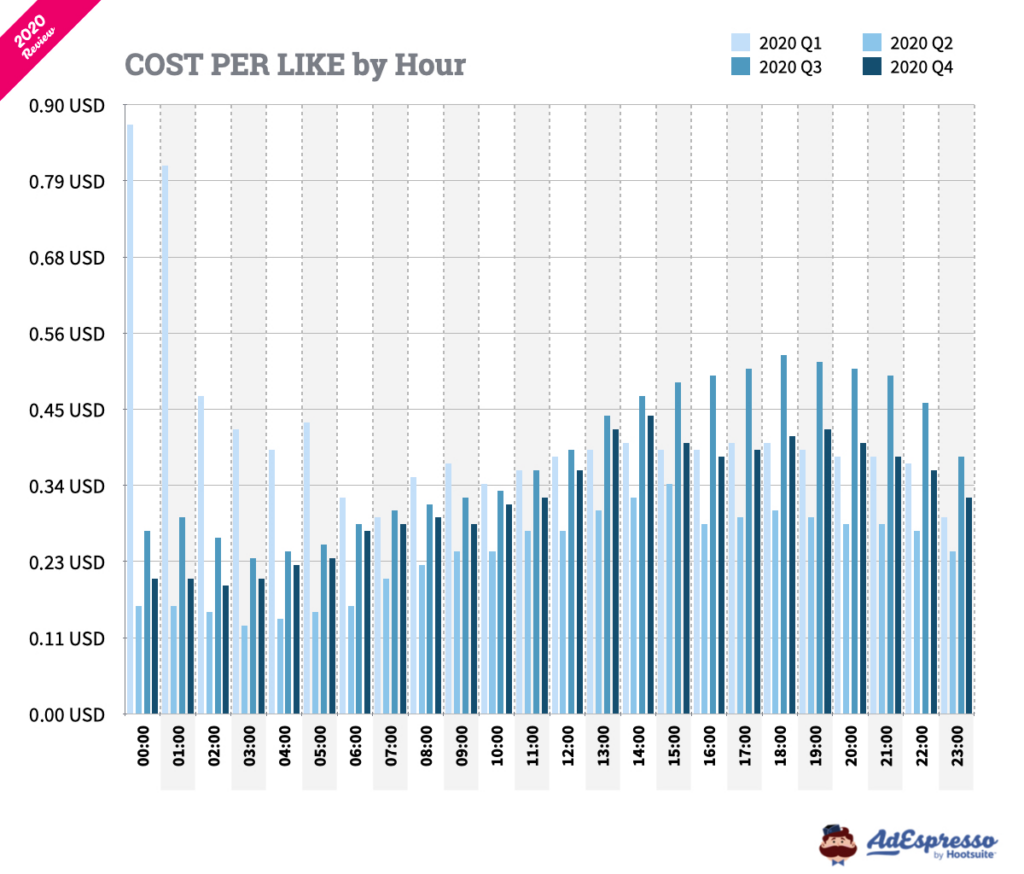
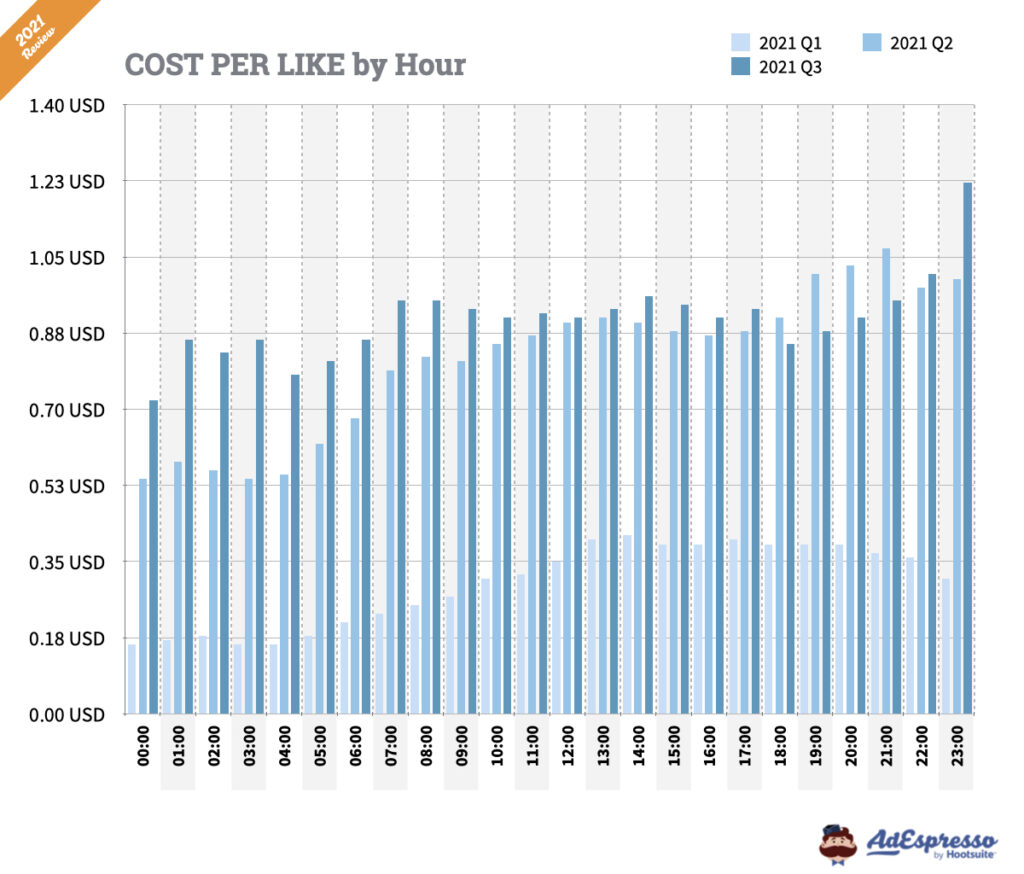
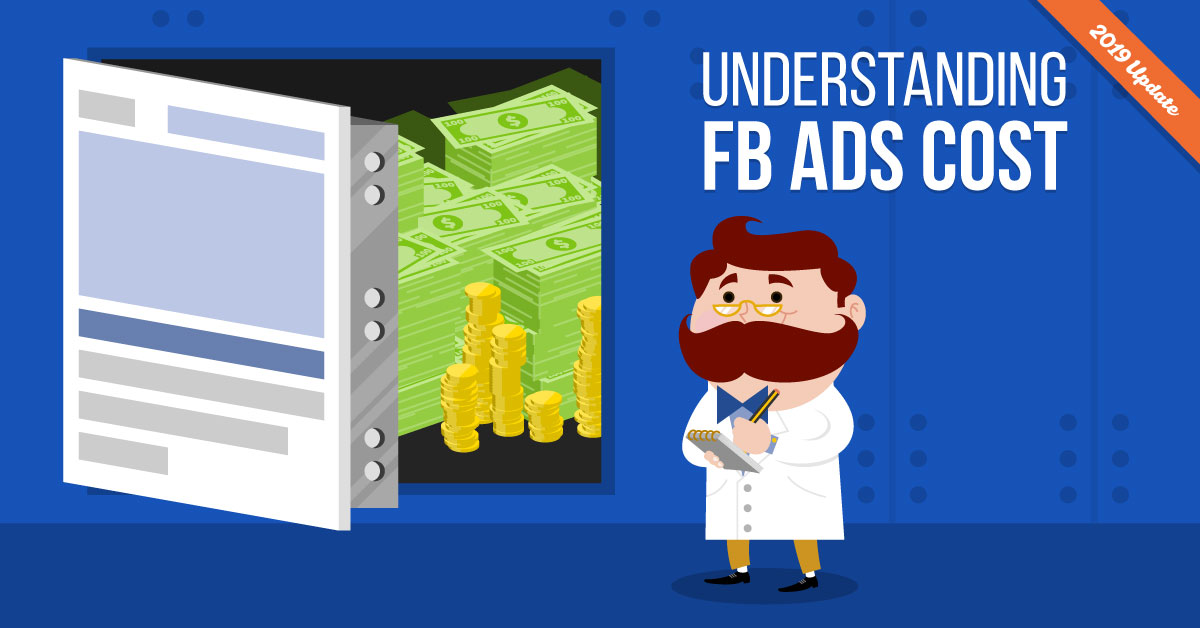

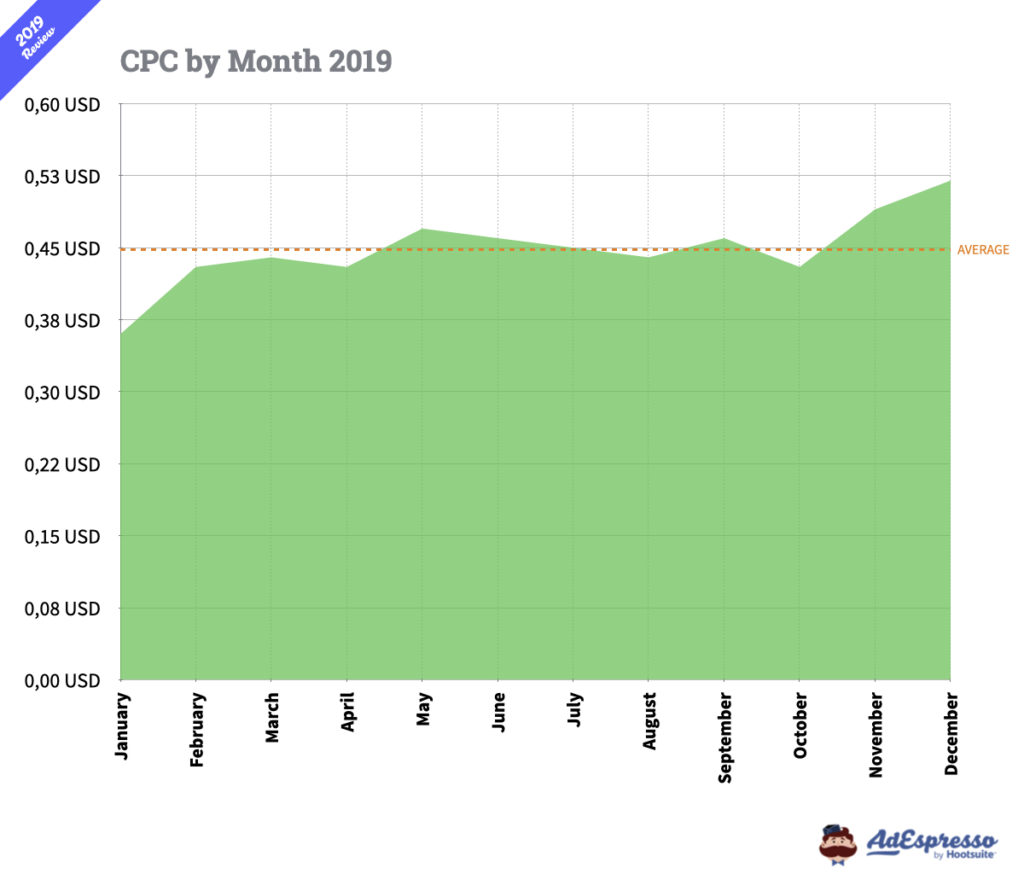
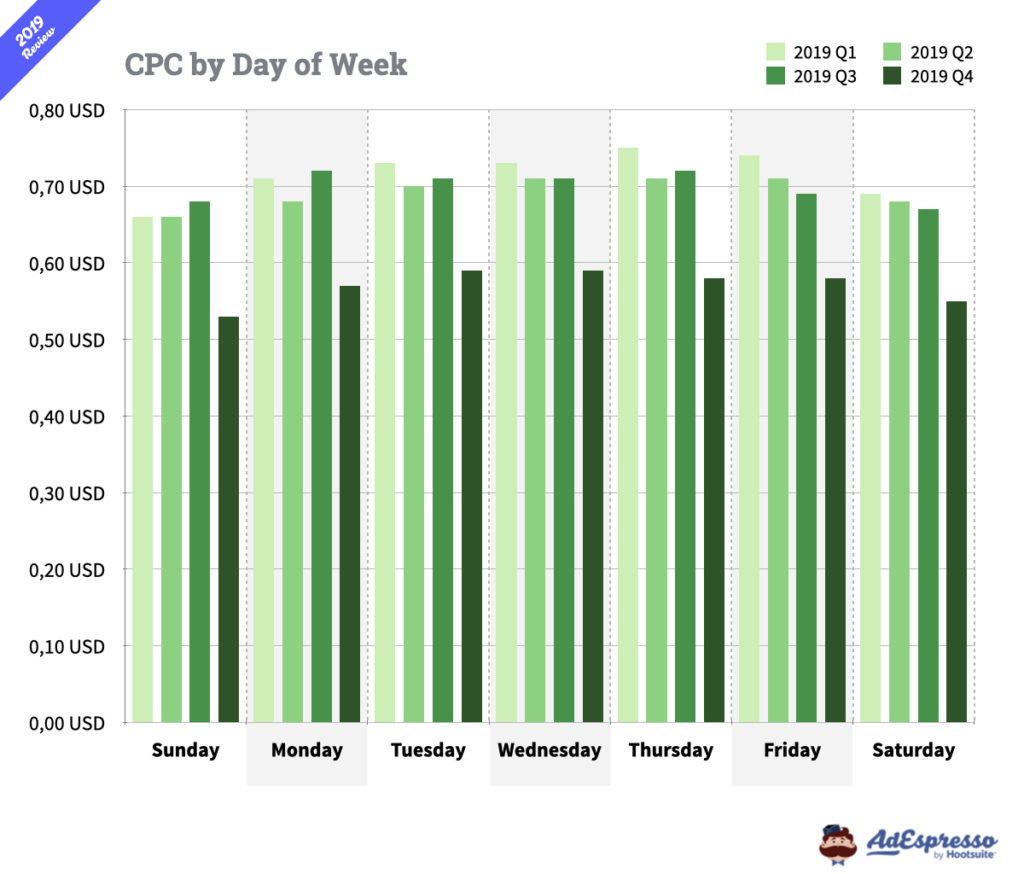
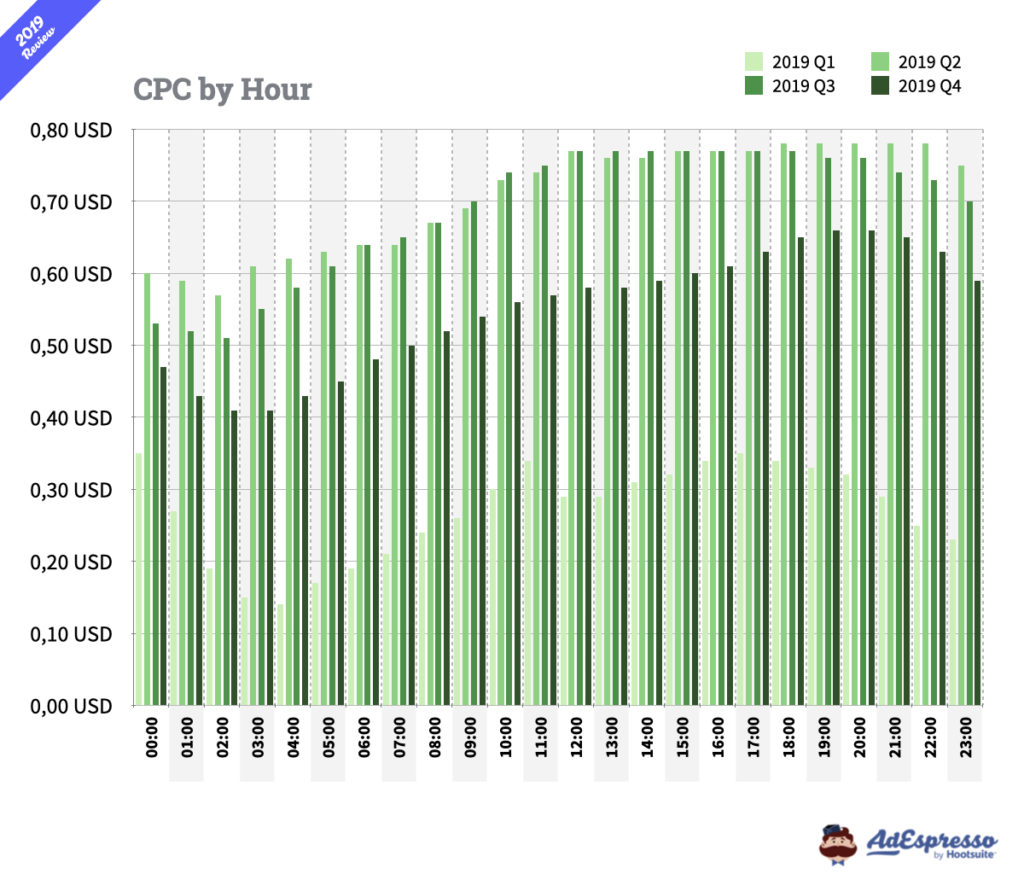
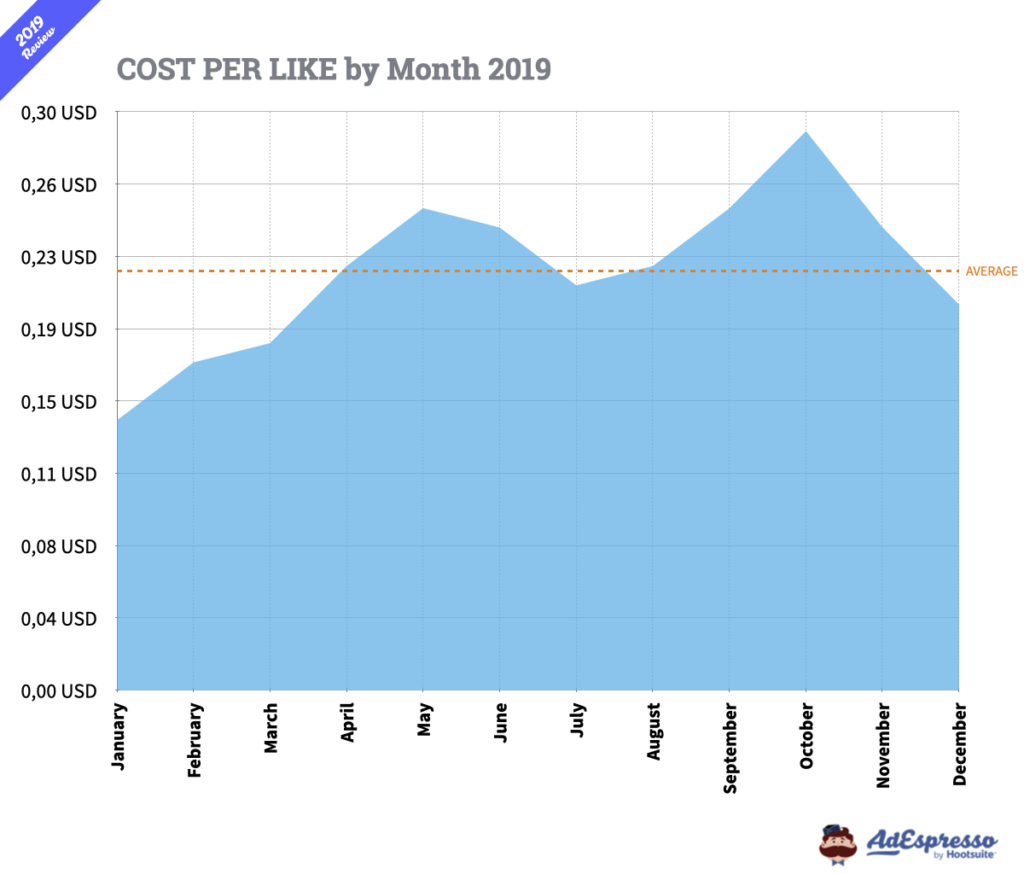
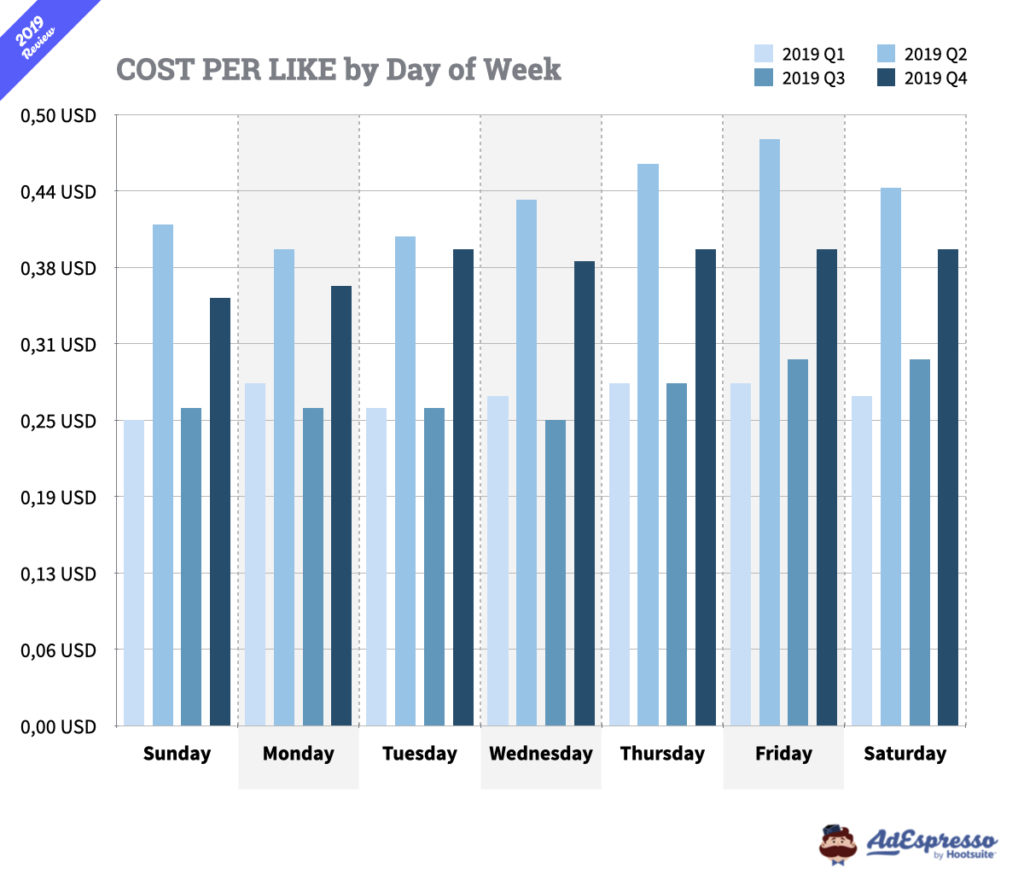
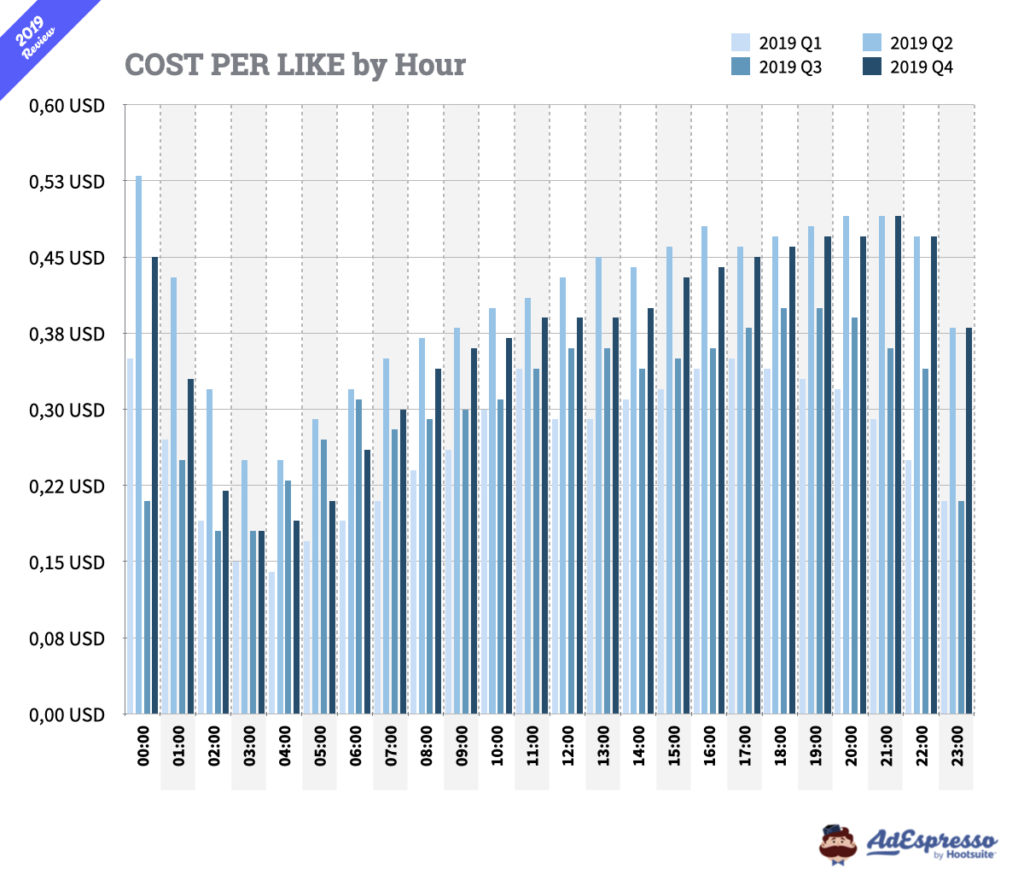

Great Article about some thoughts never read anywhere else.
I would also love to know how FB deals the target group “roll out” on each new (but same target group) campaign.
Assuming I start a new campaign each week, will always the the same first people in my target group see the new Ad – or will the people be mixed by random?
Hi Ana,
Could you please share how we can get Facebook invoicing as a payment method instead of a credit card? Please guide.
Once you start spending enough money ( tens of thousands of dollars per month but it change by country ) you’ll qualify to get a Facebok Rep following you and you can ask them to open a credit line if that’s what you meant!
There are only two Facebook blogs that I make a point of reading and paying attention too. One of them is AdExpresso.
My criteria; get one actionable idea from a post. In this AdEspresso never disappoints.
Thanks.
From a big fan
Darryl
Thanks Darryl! We do our best to keep the quality high and always provide value in each post!
Is there a way to post ads based on geofencing in Facebook?
What’s the other Darryl?
Great article and insight to see how you stack up against the average! Thank you!
Thanks, Serg!
Wow– another really impressive data analysis from AsEspresso. I’m bookmarking this for referencing when I setup my next campaign.
Also, it’s good to hear that Facebook has restored truer split-testing. That update slipped by me.
Thanks Massimo, this is a super article! Just last week, I was asking your team why I was experiencing such a large difference between the CPC in Spain and in New Zealand, for essentially the same type of advertising. Do you have enough data to say where New Zealand would be on the country graph, or even to give a guess?
Hey Ewan, New Zealand is crazy expensive on average 😛 the average CPC is $0.54 (based on > $400,000 of adspent)
Thanks For the Article,
I want to start a campaign, I will target 6 European Countries:
England,Germany,France,Netherlands,Austria,Switzerland.
and 1 OP Country
Australia.
My Question is, How Can I create each image for each country, Because For Each country I will put there country flag on the imge, I think it will work better than Non-affiliation image.
Second Question how much the a verage cost will be based about European coutries .
thank you so much
Hey David, you’ll have to create one AdSet and on Ad for each country to do this kind of campaign.
Ad for the cost you can see the averages in the post 🙂
Hey quick question,
I have started tons of ads… and recently I did one targeting video views (from a video ad I ran before). So I did a normal (conversion goal) ad using an image and it started out amazing getting me .40 cent leads. I figured it would lower raise and not stay at this and it did. However I figured worst case scenario it would still stay around $1.00 or even less. But my ads ALWAYS just keep on rising and rising….
To the point where they became useless and they cost around $2.00 now… And I’m targeting 250,000 with not much money per day so it’s not like there would be ad fatigue.
Any ideas?
thanks
What was the frequency Joseph? Even if the audience is big sometimes it may be very competitive and you may be able to reach only a small percentage of it.
Also Facebook takes in accounts many factors. If they considered your ads’ performances below the average or received negative feedback that would negatively influence your costs
Thanks for this Massimo, really great article. I’m loving your site so far, one of the best places to get information on Facebook Ads.
I have a question though. I’ve been running Facebook Ads for a client, and when I run multiple ads within an ad set (totally different copy and images, this is a Post Engagement Campaign), only one of them seems to be delievered. Read through your article and you mentioned Facebook is supposedly distributing ads within ad sets more evenly. Would like to know what you think about this.
Thanks, Massimo!
Hey Reinart, Thanks, glad you liked the article!
The announced some month ago that they were going to start distributing impressions more evenly but I agree that often this is not happening.
If you want to test more reliably the design you’ll have to create one ad per adset so each design has its own allocated budget 🙁
Great article and helped clarify a few things.
I have noticed the past week or two that the cost to covert is higher than normal. I am assuming this is because of superbowl week. Just like the Xmas season. Anyone else seeing this?
thanks!
From personal experience and data collection. Facebooks ads are not as effective as they used to be. Even when they did “work” facebook ads drove engagement and visibility. Both of which are a very roundabout inefficient way to get “sales” (if that is your goal). It’s like being a girl’s friend and doing chores for her before asking her out. The direct approach is more efficient and effect.
HOWEVER, facebook ads Used to be great for Social Currency. SMM branding may not results in sales as well as a direct marketing campaign, but social currency has intrinsic value. Not financial value, but intrinsic social feel-good value. That is important, it’s not always about $ profit.
NOW, as of Feb 2016. FB ads get a LOT of impressions at a pretty good cpm. But the engagement is weaker than it used to be, and I’ve found this across many clients in several categories. Even major ones. Still the cheapest CPC on the market, but that “click” may be a video view or a pic view or a very useless page view. Likes/Shares/Comments etc. are hard to come by these days from sponsored posts.
In fact, with one major client we tested out not making any posts whatsoever. NOT only not advertising But not even having any FB activity at all for a period of time. Did not make a difference one bit. Well, except their profits went Up because they weren’t spending on social media. But even from a social currency/branding standpoint – no difference.
It seems that facebook is for users. period. If we want to get the word out about something we need to find a better place to do it. So FB is dying in that sense.
Hey Andy, thanks for weighing in your personal experience.
I personally don’t agree and the data we have show a pretty different story honestly. Simply, like every marketing channel, Facebook is no longer the cash cow it used to be for early movers.
With more advertisers jumping on board (either because it works or because they’re all crazy) getting great results requires more skills and it’s more expensive than before. It’s the natural evolution of every channel:

If a brand doesn’t see any decrease in performances from abandoning a marketing channel then that’s probably the right thing to do. But given that more and more advertisers (small and big) are moving budget from Google to Facebook, I’d seriously question my strategy so far if it didn’t generate any result at all.
Thank you Andy. So what is your strategy right now for clients? Are you back to Google? Thank you.
If I understand the article then the cost can vary hourly over a 24 hour period depending the varying factors mentioned.
It would seem ads would have much more engagement during hours of leisure rather than say during working hours where one quickly catches up with friend posts rather than take up limited time on a break. Correct or no?
The cost can change for sure based on days and hours but right now in this post we’ve not released any data on the time/day distribution 🙂
Cheers,
Max
It helps to know the rules of the game before trying to jump in and compete. I expect to earmark a portion of my marketing budget for Facebook in the second quarter. Thanks for the information.
you need to re-evaluate your pricing. Facebook at increased its pricing in some areas (esp in the US) so that its 100 times more expensive now. I used to use facebook post boosts all the time. Now for what i used to spend 10-25 dollars on now cost over 500 to 1000 dollars on. how is it worth it to pay $20 per page like or conversion? Until fb comes down to reasonable pricing, i wouldn’t bother using it.
Mike we’ve analyzed hundreds of millions of dollars in Facebook Ads and while prices are increasing as more advertisers are jumping on board, we never saw a 20x/40x increase. I’d rather think the product you’re promoting is saturated on Facebook on there are some other reasons for the price increase.
hi Max, im having the same issue as Mike. Do you have any idea where we can complain and log the issue?
Hi guys
I am running a Facebook ad. It is set up with the objective “Send people to your website”…and is to run on “Desktop News Feed” only.
I then choose the “Links clicks to your website option” and set it to automatic bidding for link click (CPC).
All I want to be charged for are clicks that go to me website…but I’m also being charged for clicks such as when someone “likes”, “shares”, and “comments” on my ad.
As a result Facebook is giving me two costs….it shows a cost per website click…and a cost per click for all clicks to the ad.
For example the ad I am currently running it shows that I have 36 website clicks and that the cost per click of these are $1.43. Then it also shows “Clicks (all) and that number is 62 and that the CPC is 0.83.
The issue here is this….I just want to be charged for clicks to my website only which in the example above would be for 36 clicks…but I am also being charged for 26 other clicks that are made up of “likes”, “shares”, and “comments”
What can be done to stop them from charging me for those 26 other clicks…and any clicks for “likes”, “shares”, and “comments”
Chaney I am about to start my third FB campaign for a non-profit and this is the question running through my mind. Let me know how this is going for you. I would like to add this for you to see: “The way clicks are measured has changed for some objectives. For website clicks and website conversions objectives, you can now choose to optimize and get charged for link clicks. Link clicks are clicks on your ad that takes people off Facebook. Other kinds of clicks on those ads will not be counted and you won’t be charged for them if you’ve chosen to be charged for link clicks.” ( From Jon Loomer )
use website conversions objective to acheive what you mentioned
I have a question. Recently I paused a large number of my adgroups for a few days. Since I have restarted them my CPI, CPM etc have increased on nearly all of them really drastically, around 50% more. Could this be because Facebook has started from scratch checking my CTR etc and not looking at all the history? If not, what could have caused this increase in cost? Thanks
Hey Debs, yes that may likely be the cause. Even if there’s nothing official about it, it’s likely that the history, even if not totally ignored after pausing your ads, may be considered less relevant and so the learning process restart.
If an ad variation is higher cost per click but getting a lot more clicks than the other variations, would you keep it running or turn it off?
This is a tough call. Stopping the ad that is getting most of the traffic does not guarantee that the traffic will be re-routed to better performing ads. And actually the low volume/high performance ad could see a decrease in performances if you drive more traffic to it.
I’d say it really depends on how big is the spread. If the high traffic one is much more expensive, I’d probably stop it. But this is a very personal decision 🙂
Hi Massimo
you said : ” And actually the low volume/high performance ad could see a decrease in performances if you drive more traffic to it”
Does this mean that if I have a good performing ad, it’s getting worse if I raise the budget?
How do I purchase your service? I am past the free trial!
Just Login in your old account and you’ll be redirected to the subscription page. If you did the trial a while ago you can open a support ticket and ask for few days more of trial!
Cheers,
Max
Ciao Massimo,
great post, however I think it misses statistics about average CPM (or CPV) for Video Ads by Country, that’s exactly why I landed here 🙂
I’m desperately searching around for this info, with no luck till now.
Is it something you can share?
Grazie 😉
Hey Valerio 🙂 We’ll try to add them in the next update for Q2!
This site is absolutely invaluable!! I was totally nervous about a Facebook ad campaign. After reading this I feel more confident in how to proceed effectively. Thank you!!
Glad to hear that Lena!
Hey there guys,
I came across this article looking for info on a recent price hike that I came across on a client site. The Q1 2016 and April 2016 dates were the closest I could find regarding pricing, to my current situation.
The issue I’ve got is we’re seeing rates of $6-$11 PER CLICK on average from Facebook. We set the ads up in May and I recorded all of the estimated CPCs there to estimate the budget breakdown and get the client team to sign off on. The prices in 3 weeks’ time have skyrocketed over 10X – from nearly everything under $1 to everything costing several dollars per click.
I’ve run campaigns for this client and others in the past and I’ve never seen anything like this on Facebook. Have you seen anything similar recently?
My only targeting is to exclude people who already engage with the brand, and I’ve segmented the ad groups by placement, so it should be broad enough that I’m not seeing jacked up rates for super specific targeting. Screencap of Facebook’s recommended prices vs our manual bid amount: http://screencast.com/t/8zjPZzomeCQ
Thanks for any insight and feedback.
So much great info in this post. I’m always getting asked this question by clients. Thanks for summarising it all for us to geek out over 🙂
Hey,
Nice Article.
Just wondering if you could elaborate a little on the even spend per weighted for each ad you’re testing in a an adset.
Do FB weight spend evenly for a certain time then optimise. I notice that some of my ads when testing are served twice as much as another, but have a poor CTR subsquently high CPC. While other ads have an excellent CTR, high relevance score and low CPC – yet FB still serve the other underperforming ad?
It’s like they optimise too early. Does anyone find this?
I’m doing paper for a college assignment and this site is kick ass I have to compare social media services to see which will be better to advertise on for my “Company” and provide a contrasting essay or Informal report to my “employer” so this site will at least give me a great start to figuring out which social media site is best and will get our company name and product to the right audience… thanks Ad Espresso if I use any of your info you will be cited and all credit to you.. Fb page was confusing thanks again
Thanks Quincy, we’re so glad to hear this post helped you!
I’ve just begun to educate myself about FB advertising. Would you please explain the difference between “CPI” and “Spend” in your “Hourly Cost Per App Install 2015-1016” chart? Why doesn’t “Spend” track “CPI”?
Great and in depth article, if I can add my 2 cents to the topic, I think the most important part to be successful in general with media buying/PPC is being granular. Yes it is a lot of work setting up one ad for one demographic group, targeting and lading page, but this is the only way for truly uncovering the best ads/keywords/landingpage/audience combinations. You don’t even have to spend thousands of dollars, just set up a small budget for each ad to get some impressions and first glimpse of performance and the optimize further.
Hi! Thanks for tracking and sharing the data. One thing I noticed is that Singapore dropped from being the most expensive country in Asia Pac in 2016 with CPC of ~$0.80+ almost 3X higher average. However, In Q2 2016, this dropped significantly to about $0.40, which is below average. Do you know what is driving this decline? YOU did mention in your post that CPC has declined, but from #1 to below average is a massive change. Thanks!
Hi Deborah,
Good eye! I’m not sure what caused such a massive dip in CPC for Singapore – it does seem out of the ordinary. I’ll be asking our Marketplace Services team about their theory on this!
Tim
Hi Tim,
Any update on the SG cpc? I’m from Malaysia so this data is actually quite surprising would like to know what they did to achieve this.
Hey Cyrus, these are aggregated data on thousands of advertisers, we cannot provide specific insights on what was done the campaigns.
Max
What about the massive discrepancy between what facebook calls a click and what google analytics calls a visitor? Shouldn;t this factor in?
And if so, is there an aprox. across the board premium (ie multiple ) that you could boil down from your research? For instance, in our case we see 3302 facebook clicks translate into 503 referrals in google analytics.
We see very few trackable conversions coming facebook however we assume that this traffic has “top of our funnel” value and we may gain sales from some sales from those visitors through retargeting.
If you have any thoughts or links on attribution models for this, that would also be appreciated!
Thanks!
Jeremy
Hey Jeremy, have a look at this article on fake clicks. We did a pretty comprehensive experiment on the discrepancies between Google Analytics and Facebook, hope it’s useful!
Thank you for a great post!
I am a new marketer and you just got a new fan 🙂
I would love to see an article about targeting for local/small businesses.
Thanks for this useful article.
I have one question.
Can you tell me how can I reach to maximum audience in less money. Means which country or location, age group, gender, etc have to select for maximum like or post engagement in my facebook page.
If you show any graph who tell maximum reach through country wise, age group wise, gender wise etc in fixed money (i.e. $5) then its good.
Thanks
Hi Massimo Chieruzzi.. geat work.. wanted to ask one thing..if i have a low budget ad runing and its performing well and i want to increae the budget but scale it rite how an i increase the budget of a good performing ad??
Any chances that the estimated number of likes (for Page promotion) will decrease if I compare same adverts published on a regular weekday VS the same advert published on a weekend? All of the choices remain the same (image, text description, demographics, etc) but I get different estimated number of likes on a Thurs vs a Friday.
AdEspresso articles seem to be invaluable, so many insights! I have a query and would be grateful for your thoughts:
If the ultimate objective is for people to create an account on your website, is it better to optimise the ads for conversions or website clicks?
Also, what’s the best objective to run video ads?
Great article, read it all the way through!
One complaint though –
“Cost per click (CPC): You are paying only for each user that clicks on your ad. They do not have to complete the conversion and purchase on your site or sign up on your landing page; they just have to click. That being said, you aren’t paying for users who viewed your ad and didn’t convert.” –>You say users don’t have to convert, yet you’re not paying for any users that visited the ad and didn’t convert. Sooo in reality, aren’t you effectively paying only for users that convert?
Thank you for publishing and sharing a much needed benchmark.
Just curious, did you see a strong correlation between CTR and relevance scores? From my much smaller data of a few million we saw that CTR had no statistical correlation, so I am wondering if it has to do with other factors.
Hi
Thx for the great article.
I have a question thought. What do think of dramatic variations on CPA, from one day to another, running exactly the same ad.
Example
Day 1 : CPA = 12,5€ (made 40 conversion and spent around 500€)
Relevance score = 4
Day 2 : CPA = 55 €, (made 3 conversions and campaign seem to stop delivering at 10 am… ).
Relevance score = 6 !
No changes made on the campaign beetween day 1 and day 2.
Note: i have been running the same campaign for 1 year with stable results from one day to another.
Since october I have variations like this almost every day (seems like there is no historiscal data used to optimize the delivery).
I use ocpm campaign.
No doubt, a great information.
Hi Ana,
I am running Facebook campaign from last two months, i just want to know “why Facebook campaign CPC (Bid) high on week days”, Please suggest me how to keep it same as weekdays.
Thanks
There is a easy way_Allavsoft which can download all facebook 360 videos and other Facebook videos to any video format with any video resolution.
It may sound odd, but we’ve found last year that the Page Category has an impact on CPCs. We discovered it by mistake, when we had to change the Page Category of one of our clients because it was not accurate. We had the surprise to see the CPC go up instantly.
We run the same experiment many times with other clients and saw the CPC fluctates everytime.
THX for Information
Hello,
Does anybody have a list of the lowest cost per click cities or zip codes in the U.S.?
Is there a limit on how much you should spend on each ad set? also what should your limit spend be per 1million people? example would it be pointless to spend 5k on reaching a million people etc..
This is fantastic info however i’m still left with the question i came here to solve, i am hoping this comment will help. Why is it that everyone keeps stating such low numbers when referring to optimising for conversions but when i create an audience of 11 million or 11 thousand of specific niches or completely broad i cant get the Facebook suggested bid price below $15 per conversion for multiple sites in multiple industries. It seems no mater how much i experiment to find how to get it as low as website clicks i just cant see a viable number. However everyone who is selling Facebook ads training or FB ads software states number in the cents range. If you could point me in the right direction it would be greatly appreciated. Cheers
Can Facebook tell me how many total US users have specified sur-names, based on a list of sur-names I provide? If they can tell me, can they then tell me the cost(s) of as Ad campaign to touch them?
Hey, great article!
Just wondering, do you have any specific data about video costs on FB? Would be nice to get a CPM benchmark for the video views objective. Anyone with a rough average?
Thanks
Hi! I live in Australia and I see the costs are much higher here. However it is not obvious from your graphs whether the cost is drawn from advertisers who run their business from Australia or the cost is for targeting Australians. In many cases this may be the same, but not always. Please could you clarify?
Lovely and great post here Josh. I am inclined to believe that this will work totally. Because I am giving it a trial ritght away. Some folks who claim to be expert suggested I target the high ranked countries like the US, UK Canada directly by duplicating post with 0.005$ CPC. But with this honest and sincere guide, it shows total truth without selfishness. I must confess most successful entrepreneurs will not display this secret. Once again thanks so much
Hi, I have a question, I’m trying to create a traffic ad, and I’m wondering why the suggested bid by FaceBook is so high compare to this study?
So here is a test to show you what I mean:
Audience: United States, 18 to 65+, All gender,
Potential reach: 197 000 000 people
Suggested bid by FB: $2,10 USD or this gap: $1,62-$2,88
In this study, the CPC is $0,26 for US, so why the suggested bid by FB is near to 10 times bigger?
Thank you for your answers!
I think i am doing ok – i am a new page 1 year old, first 100 likes cost approximately 50p per like, grew the site with content and the next 200 likes cost me £20. I am at 380 likes now and spending just £3 a day at 10p per like. My likes are from the UK only. Email list is also growing slowly – Question is, it seems like i can buy 100,000 likes for £10,000 (at current running rate). Is there any resale value in my UK based Facebook page? I am also on google adsense and website is monetised. I want 100,000k fans to sell to.
Most of the comments here are of January 2016 and the data is of Q42016 – how is that possible? Also what could be the reason that the Q1 CPC be higher than the Q4CPC?
Really Informative. Thank you.
This is very helpful – are the figures all in US dollars or the local currency?
US dollars Paul
Great article. I didn’t take a deep dive into the Facebook auction till now. Very helpful
Hi all,
I’ve been comparing the estimated reach between the Brand Awareness campaign and Traffic campaign (CPM) and I’ve found that the figures presented were strange. The estimated reach for Brand Awareness campaign were always lower than the Traffic campaign (see below for e.g.). I’ve tested this using different saved audiences. I just want to know, why are the numbers between the 2 campaigns different? and what makes them different?
Brand Awareness (CPM): Est daily reach results up to 46,000
Traffic (CPM): Est daily reach results up to 340,000
Could you please explain me this:
1. Impressions (CPM): You’re paying for cost per 1,000 impressions. The cost per impressions is much lower than a cost per click, and when you want to get a lot of eyes on your ad, this can be a good way to go.
2. In just the USA, the average cost per click (CPC) of Facebook Ads in Q3 2016 was 27.29 cents (and 27.40 cents for ALL objectives). The cost per 1000 impressions (CPM) based on Q3 was $7.19 (and $7.34 CPM for ALL objectives).
So, you’re firstly telling us the CPM cost is much lower than CPC, and then you’re telling us that average CPC is $0.27 while CPM is $7.19. It appears CPM is 26x higher than CPC.
Which is true?
CPC is cost per 1 click
CPM is cost per 1000 impressions
For 1000 clicks you’d pay $272.9, which is 38x higher than 1000 impressions.
Dear Massimo/Adespresso team where can I check average CPC for México
You say that Q4 is the most expensive because of big brands using it for winter sales but the graphs and numbers seem to indicate different … How did you come to the conclusion then?
Great informative article which is perfect for our audience of new startup companies. I will definitely share this with our growing community of entrepreneurs who can absolutely benefit from your studies and the ebook. Thanks!
Hello,
I want to know what will be the average cost of like on the facebook page.
Hi Massimo,
Great article !
In 2017, why is the gap so wide between the cost per app install by gender (lower than $2.59 for women or $1.44 for men), compared to by country (higher than $3.70) ?
Thanks
Such an awesome post. Loved it.
Why are the CPC by placement costs so different in this graph than in the graph on the IG CPC by placement table in this article: https://adespresso.com/blog/instagram-ads-cost/
It has the same time frame and channels. Which one is right?
Hi,
can we get full list of the average CPC by country? There are a lot of countries missing.
Thank you
I have a question.
I have movie website in my native language. And I am using AdSense on it. Unfortunately cpc is bad so I earn about 0.05 – 0.07 per click.
I was wondering about something else.
To make Facebook page, target worldwide audience speaking English that like movies.
Make another web page, put AdSense on it and try to earn that way as well.
My worldwide target would cost about 0.003 per page like.
And I don’t know how much I can get cpc for AdSense from that low paying countries, but let’s say 0.01 (I haven’t seen less) with 100 clicks on ads per day I would earn close to what I am earning now with my page that has about 100k a month.
And this would be much easier to get people.
Do you think it worked worth it?
And don’t forget, I am not looking to earn big money, 3-5 $ a day would be great for me. I currently earn about 3 $ a day and I am pleased with it.
With 0.003 and 150$ in Facebook ads I get about 45-50 000 Facebook likes.
Would it be worth it?
Your blogs are really contains very important information. Thank You
This post was really very informative. Thank You
I have a little question about the measuring of the CPC, did you use CPC (cost per link click) or CPC (All)?
Because Facebook allows to report both of these, but there is no saying which one was used through your insightful reporting.
Thank you very much for the clarification 🙂
I have some questions about how this data is calculated. To me it looks flawed, particularly the Cost Per Like data. For example:
1) Based on the dotted red line in the chart, the AVERAGE cost per like by country appears to be $1.08 per like.
2) In the very next chart, the HIGHEST average cost per like by age range is somewhere slightly less than $0.35.
3) The AVERAGE cost per like by month is only $0.13.
These three outcomes are appear to be mathematically inconsistent, and logically impossible. Could you please explain how the above 3 are possible?
Thanks,
Lee
Great data being shared here on CPM and other ad costs. Thanks for all the insight and time spent putting all this together in 1 place.
This post was very informative. Thx
I have a question.
Great article. Have you found any research/data on global and country average CTR’s?
Does anyone know if there is an average / typical cost per conversion, for a startup e-commerce site on a budget? How much do i need to spend per day and how many conversions will that give me on average? Lets say I only spent $5 per day for 2 weeks every month on fb desktop ads. And my profit per sale item on my site is $10 average. Is it possible to get a good return on investment there?
Why is Australia excluded from allot of data reported but places like kazakhstan included? Maybe Borat is using Facebook Ads?
Thanks for this insightful blog. Its true that estimating facebook ad spent is really difficult.
good post
Great article, any chance to get some ads cost info for the 2018?
we’re working on it! 🙂
Awesome Post… Enjoyed… 😃
Things now make a lot of sense to me.
It costs soo much to show your ads on tier one countries. The cpc is very very high. Facebook even charges for impressions.
Thanks for this, i appreciate.
A great information that you shared. I learned a lot!!
Nice way of explaining the complete Facebook advertising strategy, Helped me so much to gain more Information about this.
What a fantastic article. Before reading this article I myself did not know the fact that CPC can vary even by hours and months. I used to wonder why sometimes I get very higher CPC when promoting my blog post for the same audience that has given me much less CPC in the past. Thanks for all those graphs related to CPC Statistics. It is very helpful. It would definitely help me to come into better conclusions in relation to my facebook ads campaign cost per click.
Good article, as someone said above, this helps you to know game rules before jumping and compete. I’ve only used Instagram for paid ads but I’m considering to start working with Facebook. I’ve had no issue with IG but anyway you can get larger traffic and raise up the conversions isn’t bad trying, especially if fees are lower. Thank you!
I appreciate you shedding some light on my Facebook marketing spend.
Another awesome post, as usual guys. Thanks.
Here’s my $0.02:
Understanding what doesn’t work is hugely important when you’re launching a brand, because it tells you which campaigns to shut off quickly, so you can shift the budget to the next iteration of the insight you want to learn, i.e., value propositions, price testing, model testing, and any number of other valuable data points.
This iterative process takes time. Facebook, for example, requires a certain amount of conversions to go through an ad set for the algorithm to start to work and ultimately find other people to purchase your product. There’s no hard number for this rule, but 50 conversions a week is a smart place to start.
For example, if you need 50 conversions a week per ad set, and your product costs $100, you need to spend $5000 in a week to get that ad set to work how it should. From there, you can back out your budget and estimate out how much you need overall.
We blogged about this today if you’re curious: https://bit.ly/2YedYkF
Hope that’s useful!
Great read! I recently started advertising my business on Facebook and it has not been without challenges. This article is super helpful, I can’t wait to try some of these tips. This article really helped me figure out my budget so I’m happy to learn more.
Amazing information actually I want to run facebook ads for real estate so will it be worth it.
This blog was… how do you say it? Relevant!! Finally I’ve found something which helped me. Cheers!
by traffici5